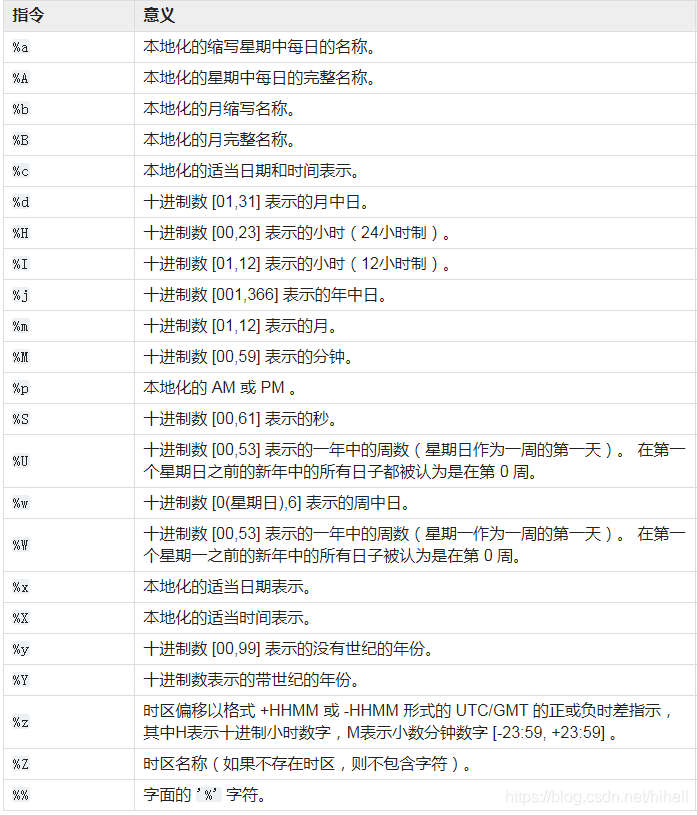在 Python 中是没有原生数据类型支持时间的,日期与时间的操作需要借助三个模块,分别是 time、datetime、calendar。
time 模块可以操作 C 语言库中的时间相关函数,时钟时间与处理器运行时间都可以获取。datetime 模块提供了日期与时间的高级接口。calendar 模块为通用日历相关函数,用于创建数周、数月、数年的周期性事件。
在学习之前,还有一些术语要补充一下,这些术语你当成惯例即可。这里在 Python 官方文档中也有相关说明,不过信息比较多,橡皮擦为你摘录必须知道的一部分。
epoch(纪元) 是时间开始的点,其值取决于平台。
对于 Unix, epoch(纪元) 是 1970年1月1日00:00:00(UTC)。要找出给定平台上的 epoch ,请使用 time.gmtime(0) 进行查看,例如橡皮擦电脑显示:
time.struct_time(tm_year=1970, tm_mon=1, tm_mday=1, tm_hour=0, tm_min=0, tm_sec=0, tm_wday=3, tm_yday=1, tm_isdst=0)
术语 纪元秒数 是指自 epoch (纪元)时间点以来经过的总秒数,通常不包括闰秒。 在所有符合 POSIX 标准的平台上,闰秒都不会记录在总秒数中。
程序员中常把 纪元秒数 称为 时间戳。
time 时间模块
该模块核心为控制时钟时间。
get_clock_info 函数
该函数获取时钟的基本信息,得到的值因不同系统存在差异,函数原型比较简单:
time.get_clock_info(name)
其中 name 可以取下述值:
monotonic:time.monotonic()perf_counter: time.perf_counter()process_time: time.process_time()thread_time: time.thread_time()time: time.time()
该函数的返回值具有以下属性:
adjustable : 返回 True 或者 False。如果时钟可以自动更改(例如通过 NTP 守护程序)或由系统管理员手动更改,则为 True ,否则为 False ;implementation : 用于获取时钟值的基础 C 函数的名称,就是调用底层 C 的函数;monotonic :如果时钟不能倒退,则为 True ,否则为 False;resolution : 以秒为单位的时钟分辨率( float )。
import time
available_clocks = [
('clock', time.clock),
('monotonic', time.monotonic),
('perf_counter', time.perf_counter),
('process_time', time.process_time),
('time', time.time),
]
for clock_name, func in available_clocks:
print('''
{name}:
adjustable : {info.adjustable}
implementation: {info.implementation}
monotonic : {info.monotonic}
resolution : {info.resolution}
current : {current}
'''.format(
name=clock_name,
info=time.get_clock_info(clock_name),
current=func()))
运行结果如下图所示。

上图显示橡皮擦的计算机在 clock 与 perf_counter 中,调用底层 C 函数是一致的。
获取时间戳
在 Python 中通过 time.time() 函数获取纪元秒数,它可以把从 epoch 开始之后的秒数以浮点数格式返回。
import time
print(time.time())
# 输出结果 1615257195.558105
时间戳大量用于计算时间相关程序,属于必须掌握内容。
获取可读时间
时间戳主要用于时间上的方便计算,对于人们阅读是比较难理解的,如果希望获取可读时间,使用 ctime() 函数获取。
import time
print(time.ctime())
# 输出内容:Tue Mar 9 10:35:51 2021
如何将时间戳转换为可读时间,使用 localtime 函数即可。
localtime = time.localtime(time.time())
print("本地时间为 :", localtime)
输出结果为 class 'time.struct_time'> 类型数据,后文将对其进行格式化操作:
本地时间为 : time.struct_time(tm_year=2021, tm_mon=3, tm_mday=9, tm_hour=10, tm_min=37, tm_sec=27, tm_wday=1, tm_yday=68, tm_isdst=0)
上述代码中的时间戳最小值是 0,最大值由于 Python 环境和操作系统决定,我本地 64 位操作系统进行测试的时候,得到的数据如下:
import time
localtime = time.localtime(0)
print("时间为 :", localtime)
# 时间为 : time.struct_time(tm_year=1970, tm_mon=1, tm_mday=1, tm_hour=8, tm_min=0, tm_sec=0, tm_wday=3, tm_yday=1, tm_isdst=0)
localtime = time.localtime(32536799999)
print("时间为 :", localtime)
# 时间为 : time.struct_time(tm_year=3001, tm_mon=1, tm_mday=19, tm_hour=15, tm_min=59, tm_sec=59, tm_wday=0, tm_yday=19, tm_isdst=0)
localtime = time.localtime(99999999999)
print("时间为 :", localtime)
# OSError: [Errno 22] Invalid argument
print(type(localtime))
单调时间 monotonic time
monotonic time 从系统启动开始计时,从 0 开始单调递增。
操作系统的时间可能不是从 0 开始,而且会因为时间出错而回调。
该函数原型如下,不需要任何参数,返回一个浮点数,表示小数秒内的单调时钟的值:
测试代码如下:
print("单调时间",time.monotonic())
# 输出:单调时间 12279.244
处理器时钟时间
time() 函数返回的是纪元秒数(时间戳), clock() 函数返回的是处理器时钟时间。
该函数函数的返回值:
- 在第一次调用的时候,返回的是程序运行的实际时间;
- 在第二次之后的调用,返回的是自第一次调用后到这次调用的时间间隔。
需要注意的是 Python 3.8 已移除 clock() 函数,用 time.perf_counter() 或 time.process_time() 方法替代。
t0 = time.clock()
# 运行一段代码
print(time.clock() - t0, "程序运行时间")
我使用的 Python 版本较高,提示异常如下:
time.clock has been deprecated in Python 3.3 and will be removed from Python 3.8: use time.perf_counter or time.process_time instead t0 = time.clock()
性能计数器 time.perf_counter
perf_counter() 函数的 epoch (纪元)是未定义的。一般使用该函数都是为了比较和计算,不是为了用作绝对时间,该点需要注意下。
该函数用于测量较短持续时间的具有最高有效精度的时钟,包括睡眠状态消耗的时间,使用两次调用才会有效。
测试代码如下:
t0 = time.perf_counter()
# 运行一段代码
for i in range(100000):
pass
print("程序运行时间", time.perf_counter() - t0)
与其类似的函数有 perf_counter_ns()、process_time()、process_time_ns(),具体可以查询手册进行学习,先掌握 perf_counter() 函数即可。
时间组件
上文已经涉及了时间组件相关的知识,通过 localtime 得到的 struct_time 类型的数据。
这里涉及到的函数有 gmtime() 返回 UTC 中的当前时间,localtime() 返回当前时区对应的时间,mktime() 接收 struce_time 类型数据并将其转换成浮点型数值,即时间戳。
print("*"*10)
print(time.gmtime())
print("*"*10)
print(time.localtime())
print("*"*10)
print(time.mktime(time.localtime()))
struct_time 类型包含的内容
上述代码返回的数据格式为:
time.struct_time(tm_year=2021, tm_mon=3, tm_mday=9, tm_hour=12, tm_min=50, tm_sec=35, tm_wday=1, tm_yday=68, tm_isdst=0)
其中各值可以根据英文含义进行理解 :tm_year 年份(range[1,12]),tm_mon 月份(range[1,12]),tm_mday 天数(range[1,31]),tm_hour 天数(range[0,23]),tm_min 分钟 (range[0,59]), tm_sec 秒数 (range[0,61]), tm_wday 星期 (range[0,6],0 是星期日), tm_yday 一年中的一天(range[1,366] ),tm_isdst 在夏令时生效时设置为 1,而在夏令时不生效时设置为 0,值-1 表示这是未知的。
解析和格式化时间
strptime() 和 strftime() 函数可以使时间值在 struct_time 表示和字符串表示之间相互转换。
对于 strftime 函数,其中的参数参考官方即可。
x = time.strftime("%Y-%m-%d %H:%M:%S", time.localtime())
print(x)

这里的学习,没有什么难度大的点,孰能生巧的知识。
strptime 函数的应用
x = time.strftime("%Y-%m-%d %H:%M:%S", time.localtime())
print(x)
# 方向操作,字符串格式化成 time.struct_time
struct_time = time.strptime(x, "%Y-%m-%d %H:%M:%S")
print(struct_time)
需要记忆的就是 strftime 与 strptime 函数只有中间的字符不同,一个是 f ,另一个是 p。
time 小节
对于 time 模块,sleep 函数属于必备知识点,但是太常用了,你肯定已经很熟悉了。
对于模块的学习,最权威的就是官方手册了,time 模块
datetime 模块
该模块比 time 模块高级了很多,并且对 time 模块进行了封装,提供的功能更加强大了。
在 datetime 模块中,Python 提供了 5 个主要的对象类,分别如下:
datetime:允许同时操作时间和日期;date:只操作日期;time:只操作时间;timedelta:用于操作日期以及测量时间跨度;tzinfo:处理时区。
date 类
优先展示部分该类的属性和方法,都是记忆层面的知识。
min、max:date 对象能表示的最大、最小日期;resolution:date 对象表示日期的最小单位,返回天;today():返回表示当前本地日期的 date 对象;fromtimestamp(timestamp):根据时间戳,返回一个 date 对象。
测试代码如下:
from datetime import date
import time
print('date.min:', date.min)
print('date.max:', date.max)
print('date.resolution:', date.resolution)
print('date.today():', date.today())
print('date.fromtimestamp():', date.fromtimestamp(time.time()))
输出结果:
date.min: 0001-01-01
date.max: 9999-12-31
date.resolution: 1 day, 0:00:00
date.today(): 2021-03-09
date.fromtimestamp(): 2021-03-09
date 对象的属性和方法
通过下述代码创建一个 date 对象:
d = date(year=2021,month=3,day=9)
print(d)
该对象具备下述属性和方法:
d.year:返回年;d.month:返回月;d.day:返回日;d.weekday():返回 weekday,如果是星期一,返回 0;如果是星期 2,返回 1,以此类推;d.isoweekday():返回 weekday,如果是星期一,返回 1;如果是星期 2,返回 2,以此类推;d.isocalendar():返回格式如(year, wk num, wk day);d.isoformat():返回格式如'YYYY-MM-DD'的字符串;d.strftime(fmt):自定义格式化字符串,与 time 模块中的 strftime 类似。
time 类
time 类定义的类属性:
min、max:time 类所能表示的最小、最大时间。其中,time.min = time(0, 0, 0, 0), time.max = time(23, 59, 59, 999999);- resolution:时间的最小单位,这里是 1 微秒;
通过其构造函数可以创建一个 time 对象。
t = time(hour=20, minute=20, second=40)
print(t)
time 类提供的实例方法和属性:
t.hour、t.minute、t.second、t.microsecond:时、分、秒、微秒;t.tzinfo:时区信息;t.isoformat():返回型如”HH:MM:SS”格式的字符串时间表示;t.strftime(fmt):返回自定义格式化字符串。
datetime 类
该类是 date 类与 time 类的结合体,很多属性和方法前文已经介绍,再补充一些比较常用的属性和方法。
获取当前的日期与时间:
from datetime import datetime
dt = datetime.now()
print(dt)
获取时间戳:
dt = datetime.now()
# 使用 datetime 的内置函数 timestamp()
stamp = datetime.timestamp(dt)
print(stamp)
timedelta 类
通过 timedelta 函数返回一个 timedelta 时间间隔对象,该函数没有必填参数,如果写入一个整数就是间隔多少天的的意思。
# 间隔 10 天
timedelta(10)
# 跨度为1 周
timedelta(weeks=1)
两个时间间隔对象可以彼此之间相加或相减,返回的仍是一个时间间隔对象。
一个 datetime 对象如果减去一个时间间隔对象,那么返回的对应减去之后的 datetime 对象,然后两个 datetime 对象如果相减,返回的是一个时间间隔对象。
更多关于 datetime 类使用的知识,可以参考官方手册。
calendar 模块(日历)
此模块的函数都是日历相关的,例如打印某月的字符月历。
calendar 模块定义了 Calendar 类,它封装了值的计算, 例如给定月份或年份中周的日期。通过 TextCalendar 和 HTMLCalendar 类可以生成预格式化的输出。
基本代码:
import calendar
c = calendar.TextCalendar(calendar.SUNDAY)
c.prmonth(2021, 3)
上述代码,默认是从周日开始的,输出结果:
March 2021
Su Mo Tu We Th Fr Sa
1 2 3 4 5 6
7 8 9 10 11 12 13
14 15 16 17 18 19 20
21 22 23 24 25 26 27
28 29 30 31
该模块使用频率较低,详细使用参考地址 进行学习。
总结
到此这篇关于Python玩转时间和日期库的实现的文章就介绍到这了,更多相关Python 时间和日期库内容请搜索脚本之家以前的文章或继续浏览下面的相关文章希望大家以后多多支持脚本之家!
您可能感兴趣的文章:- Python3时间转换之时间戳转换为指定格式的日期方法详解
- python获取指定时间段内特定规律的日期列表
- python (logging) 日志按日期、大小回滚的操作
- Python tkinter实现日期选择器
- Python绘制数码晶体管日期
- Pycharm创建python文件自动添加日期作者等信息(步骤详解)
- python实现按日期归档文件
- 基于python获取本地时间并转换时间戳和日期格式
- python 带时区的日期格式化操作
- 如何使用 Python 读取文件和照片的创建日期
- Python 常用日期处理 -- calendar 与 dateutil 模块的使用
- python 常用日期处理-- datetime 模块的使用
- python自动提取文本中的时间(包含中文日期)
- Python 处理日期时间的Arrow库使用
- Python 日期与时间转换的方法
- Python如何将字符串转换为日期
- python实现将中文日期转换为数字日期
- 教你怎么用python实现字符串转日期
 咨 询 客 服
咨 询 客 服